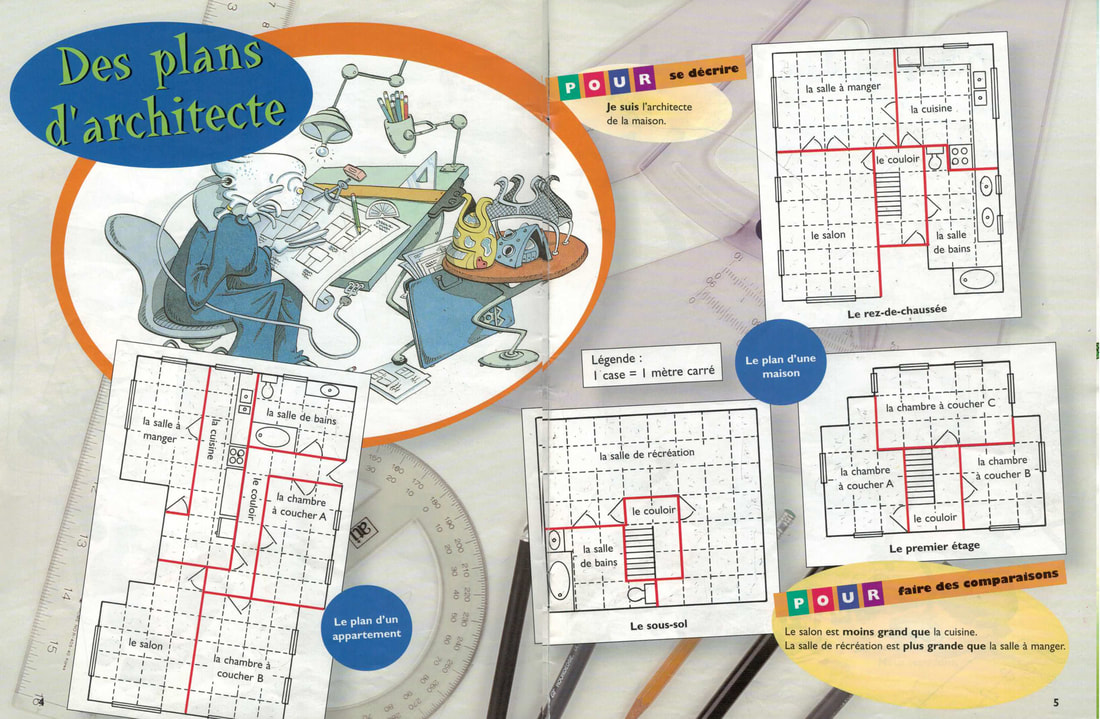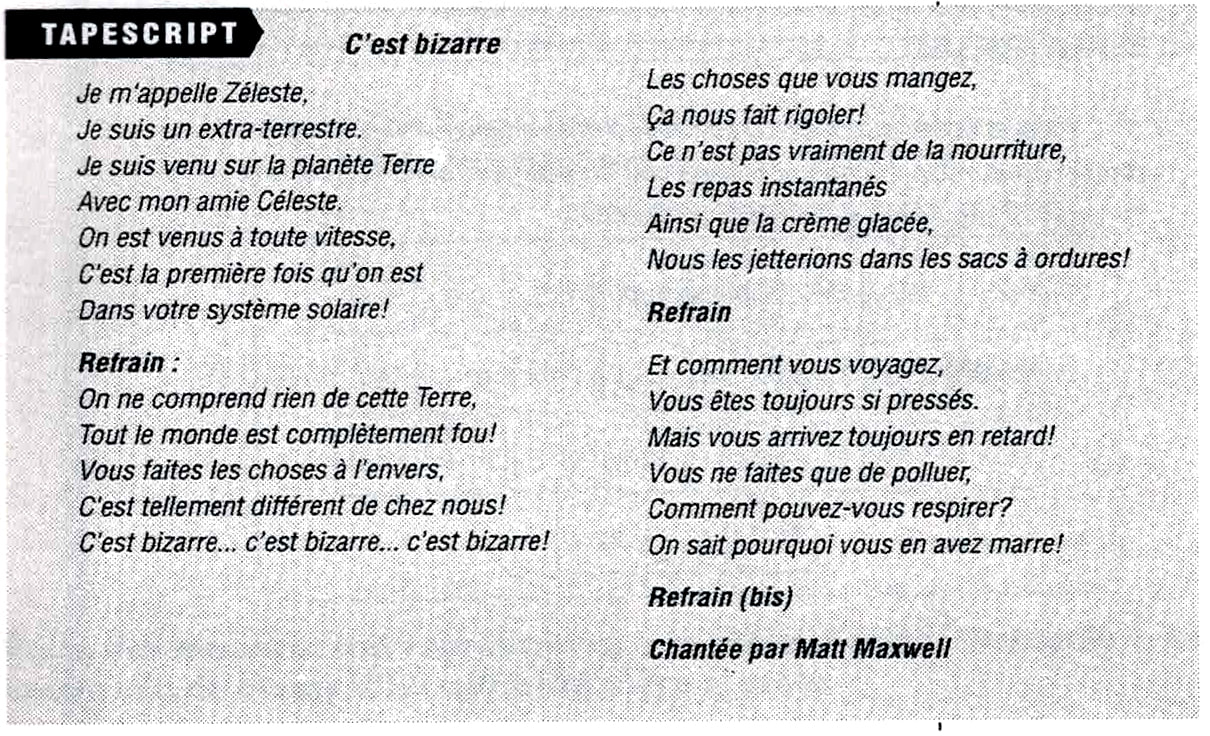Le plan de la maison
Direct translations are hidden between two pink { }. Watch out for these floating brackets! Simply drag your mouse over the brackets to highlight your translation!
All notes and explanations notes are in green.
All notes and explanations notes are in green.
Let's start this lesson listening to C'est Bizarre!!!
{My name is Zeleste, I am an alien.
I came to planet Earth with my friend Celeste.
We came at full speed, it's the first time we're in your solar system!
Refrain:
We do not understand anything about this Earth,everyone is totally crazy!
You do things backwards, it's so different from us!
It's bizarre...it's bizarre...it's bizarre!
The things you eat, they make us laugh!
It's not really food, instant meals as well as ice cream,
we would throw them in the garbage bags!
Refrain
And how you travel, you are always in a hurry.
But you always arrive late!
You just pollute, how can you breathe?
We know why you are fed-up!
Refrain}
I came to planet Earth with my friend Celeste.
We came at full speed, it's the first time we're in your solar system!
Refrain:
We do not understand anything about this Earth,everyone is totally crazy!
You do things backwards, it's so different from us!
It's bizarre...it's bizarre...it's bizarre!
The things you eat, they make us laugh!
It's not really food, instant meals as well as ice cream,
we would throw them in the garbage bags!
Refrain
And how you travel, you are always in a hurry.
But you always arrive late!
You just pollute, how can you breathe?
We know why you are fed-up!
Refrain}
What do you think life is like in another planet? Make a drawing of one aspect of life on another planet and bring it for our next class!
For us to be able to design a house, we need to first think like an architect.
To start, get a piece of blank paper.
Look at an object around the room; it can be a chair, a table, an apple or anything you choose.
To start, get a piece of blank paper.
Look at an object around the room; it can be a chair, a table, an apple or anything you choose.
Est-ce que les deux dessins sont differents?
{Are the two drawings different?}
{Are the two drawings different?}
Planning like an architect

Regardez les plans aux pages 4 et 5 de votre livre (image ci-dessus). Il y a le plan d'un appartement et le plan d'une maison. {Look at the plans on pages 4 and 5 of your book (image above). They are a plan for an appartment and a plan for a house.}
What do you notice?
How many rooms can you see? On an architect's plan, all rooms are seen from above.
Regardez le rez-de-chaussee, le premier etage et le sous-sol. {Notice the ground floor, the first floor and the basement.}
Also, notice the legend, which states that every square equals one square metre.
What do you notice?
How many rooms can you see? On an architect's plan, all rooms are seen from above.
Regardez le rez-de-chaussee, le premier etage et le sous-sol. {Notice the ground floor, the first floor and the basement.}
Also, notice the legend, which states that every square equals one square metre.
Now, using the image above, let's complete page 6 on the workbook.
Les cases indiquent les dimensions de chaque pièce. Chaque case égale un mètre carré. {The boxes indicate the dimensions of each room. Each box equals one square metre.}
Identify each room, count the number of squares for that particular room and note that number on the chart. That number you found is actually the dimension of that room in square metres.
Completez chaque section. {Complete each section.}
For instance, if I count how many squares are on the house's bathroom, I see 10 squares; so, I will add "bathroom" to the first line on my Piece column, and add "10" to my dimension column.
Les cases indiquent les dimensions de chaque pièce. Chaque case égale un mètre carré. {The boxes indicate the dimensions of each room. Each box equals one square metre.}
Identify each room, count the number of squares for that particular room and note that number on the chart. That number you found is actually the dimension of that room in square metres.
Completez chaque section. {Complete each section.}
For instance, if I count how many squares are on the house's bathroom, I see 10 squares; so, I will add "bathroom" to the first line on my Piece column, and add "10" to my dimension column.
| pg4.pdf | |
| File Size: | 8351 kb |
| File Type: | |
Quel est le plan?
12-B est l'architecte de la maison que les extra-terrestres vont construire. {12-B is the architect for the house that the aliens will build.}
Vous allez écouter 12-B décrire le plan de la maison. {You will listen to 12-B describe the plan of the house.}
Vous allez dessiner le plan de la maison des extra-terrestres. {You will draw the plan for the extra-terrestrian house.}
Vous allez écouter 12-B décrire le plan de la maison. {You will listen to 12-B describe the plan of the house.}
Vous allez dessiner le plan de la maison des extra-terrestres. {You will draw the plan for the extra-terrestrian house.}
Listen to the audio several times. Now, take the worksheet "Les plans de 12-B" below.
| pg5.pdf | |
| File Size: | 7866 kb |
| File Type: | |
Complétez le graphique à la page 7, partie A. {Complete the graph on page 7, part A.}
Complete section B on the same page.
You will compare different rooms using "Plus grande que" or "moins grande que".
{bigger / smaller}
Now, complete the following sheet with your groups. Put all of your group's names on the sheet.
Travaillez dans vos groupes. Regardez les plans. Indiquez le plan que vous preferez.
{Work with your groups. Look at the plans. Indicate the plan you prefer.}
You will compare different rooms using "Plus grande que" or "moins grande que".
{bigger / smaller}
Now, complete the following sheet with your groups. Put all of your group's names on the sheet.
Travaillez dans vos groupes. Regardez les plans. Indiquez le plan que vous preferez.
{Work with your groups. Look at the plans. Indicate the plan you prefer.}
| plan_comparison.pdf | |
| File Size: | 225 kb |
| File Type: | |
Avant notre prochaine étape, vous comparerez les pieces de la maison. {Before our next step, you will compare the rooms in the house.}
Completez chaque phrase avec la bonne expression. { Complete each phrase with the right expression.}
Vous utiliserez "moins grand que" et "plus grand que." {You will use "smaller than" and "bigger than".}
Remember to switch for feminine -- grand becomes grande!
Now you do it! Using the house plan found on page 5 (scroll up!), write a comparison of the rooms below on a separate sheet.
Exemple: Le couloir / le salon : Le couloir est moins grand que le salon.
La chambre a coucher / la cuisine
La salle a manger / la salle de bains
La salle de recreation / le salon
Le salon / la salle a manger
Completez chaque phrase avec la bonne expression. { Complete each phrase with the right expression.}
Vous utiliserez "moins grand que" et "plus grand que." {You will use "smaller than" and "bigger than".}
Remember to switch for feminine -- grand becomes grande!
Now you do it! Using the house plan found on page 5 (scroll up!), write a comparison of the rooms below on a separate sheet.
Exemple: Le couloir / le salon : Le couloir est moins grand que le salon.
La chambre a coucher / la cuisine
La salle a manger / la salle de bains
La salle de recreation / le salon
Le salon / la salle a manger
Showtime!
Faites un plan pour la maison des extra-terrestres. {Make a plan for the alien house.}
Remember to include all the information given by 12-B.
Use the graph paper below. Start by creating an outline for each floor.
You will need one sheet per floor!!! Use pencil to start.
Use the graph paper below. Start by creating an outline for each floor.
You will need one sheet per floor!!! Use pencil to start.
| graph_paper.png | |
| File Size: | 8 kb |
| File Type: | png |
Le sous-sol devrait avoir 60 carrés; le rez-de-chaussée, 65 carrés; et le premier étage, 64 carrés. { The basement should be 60 squares, the main floor should be 65 squares and the first floor should be 64 squares.}
Save this work! We will need it to build our amazing alien houses!
Self evaluation -- please fill the form below!
| selfassess-1-2.pdf | |
| File Size: | 163 kb |
| File Type: | |


